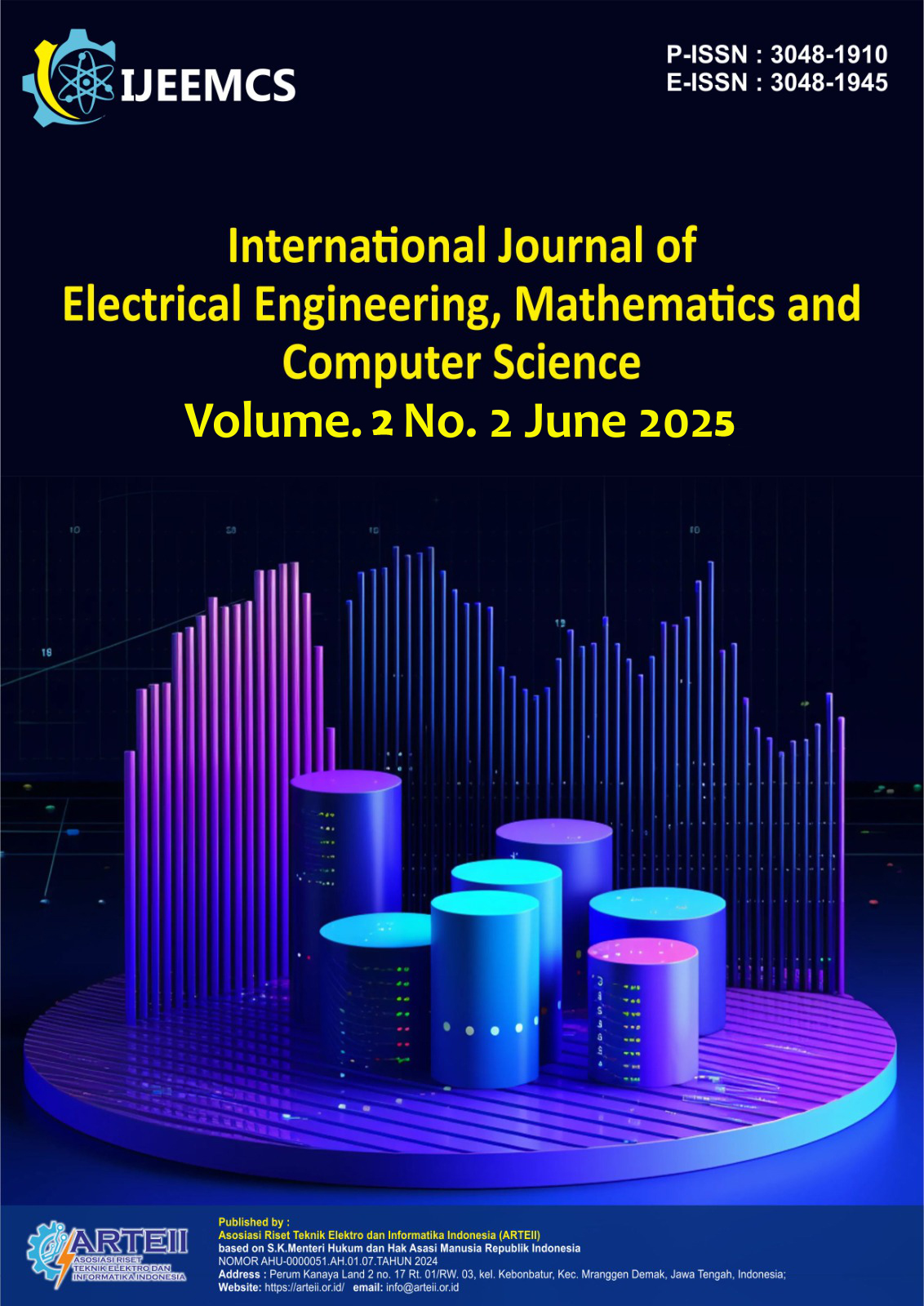Comparison of Multiple Linear Regression, Backpropagation and Fuzzy Mamdani Methods in Predicting the Revenue of PLN Takengon Unit
DOI:
https://doi.org/10.62951/ijeemcs.v2i2.263Keywords:
Back propagation, Data Mining, Fuzzy Mamdani, Multiple Linear Regression, PredictionAbstract
The performance of data mining techniques has been proven accurate in many studies, but each method in data mining techniques has different accuracy depending on the type of data that is the object of research. Methods in data mining techniques are divided into several functions, namely: clustering, association, classification, and prediction, where each data mining technique objective has a superior method. Therefore, in this case the author will compare the performance of the multiple linear regression method, and neural networks with fuzzy mamdani in predicting the income of PLN Unit Takengon. In several studies, the Backpropagation method shows the highest accuracy compared to other methods. Then the prediction model with multiple linear regression also has the highest accuracy as well as the Fuzzy Mamdani method has high accuracy too. Therefore, the purpose of this study is to compare the three methods, so that it can be determined which method has a higher accuracy value. The results of this study indicate that the Back propagation method has the highest accuracy and the lowest average error, namely a MAPE value of 5.9% with an accuracy of 94.1% and an RMSE of 14398.14, followed by the multiple linear regression method obtaining a MAPE value of 6.9% with an accuracy of 93.1% and an RMSE of 15527.41, then for Fuzzy Mamdani obtaining a MAPE value of 7% with an accuracy of 93% and an RMSE of 16077.76.
References
Aggarwal, C. C. Data Mining. New York: Springer, 2015.
Decky Irmawan, Khamami Herusantoso “ Penerapan Logika Fuzzy sebagai Sistem Penunjang Keputusan Prakiraan Cuaca”, e-Indonesia Initiative, Bandung, 2011.
Faisal, M Reza dan Dodon T. Nugrahadi. Belajar Data Science: Klasifikasi dengan Bahasa Pemrograman R. Banjar Baru: Scripta Cendekia, 2019.
Han, Jiawei dkk. Data Mining: Concepts And Techniques 3rd Edition. United States: Morgan Kaufmann. 2012.
Kharomah, Siti Ismiatul, dkk., “Implementasi Model Fuzzy-Wavelet Dan Fis Metode Mamdani Dalam Prediksi Nilai Tukar Eur/Idr”. Journal of Mathematics, Vol. 8 (2) (2019). Hal: 60-68
Kusumadewi, Sri, dan Hari Purnomo. Aplikasi Logika Fuzzy Untuk Pendukung Keputusan. Yogyakarta: Graha Ilmu, 2010
Laila dan Cahyono,“Estimasi Data Insight Social Media Ads Menggunakan Neural Network, Linear Regression dan Deep Learning” Jurnal Sistem Komputer dan Informatika Vol 4 (3) (2023) Hal:562-569
Larose, T. Daniel. Discovering Knowledge In Data: An Introduction to Data Mining. Canada: Jhon Wiley & Sons, Inc. 2005.
Maulida, Rizki, Perbandingan metode K-Nearest Neighbor (K-NN) dan Neural Network (NN) dalam prediksi harga saham PT. Telkom Indonesia Tbk (TLKM). Teknik Informatika, Fakultas Teknik Universitas Gajah Putih. Takengon, 2022.
Maulidiyah, Salasabila Talitha. Perbandingan Metode Ann-Backpropagation Dan Linear Regression Yang Telah Dioptimasi Untuk Prediksi Angka Kemiskinan Di Jawa Barat. Teknik Informatika, Fakultas Sains dan Teknologi Universitas Negeri Malang 2023.
Munir, Rinaldi. Matematika Diskrit. Bandung: INFORMATIKA, 2012
Rahmaddeni, Rahmaddeni. “Penerapan Fuzzy Logic dalam Menganalisis Tingkat Pendapatan Akhir Konsultan Produk Multi Level Marketing (Studi Kasus: PT. Orindo Alam Ayu Cabang Pekanbaru).” Jurnal Sains dan Teknologi Industri 11, no. 2 (2015) Hal: 192–199.
Wardhono, Adhitya dkk. Analisis Data Time Series Dalam Model Makroekonomi. Jawa Timur: CV. Pustaka Abadi. 2019.
Wibowo, S. Penerapan Logika Fuzzy Dalam Penjadwalan Waktu Kuliah. Informatika UPGRIS, 1(Juni) (2015), 59–77
Winnos, Hilman. Perbandingan Metode Regresi Linier dan ARIMA Untuk Prediksi Saham PT. BSI, Tbk. Teknik Informatika, Fakultas Teknik Universitas Gajah Putih. Takengon, 2022.
Downloads
Published
How to Cite
Issue
Section
License
Copyright (c) 2025 International Journal of Electrical Engineering, Mathematics and Computer Science

This work is licensed under a Creative Commons Attribution-ShareAlike 4.0 International License.





